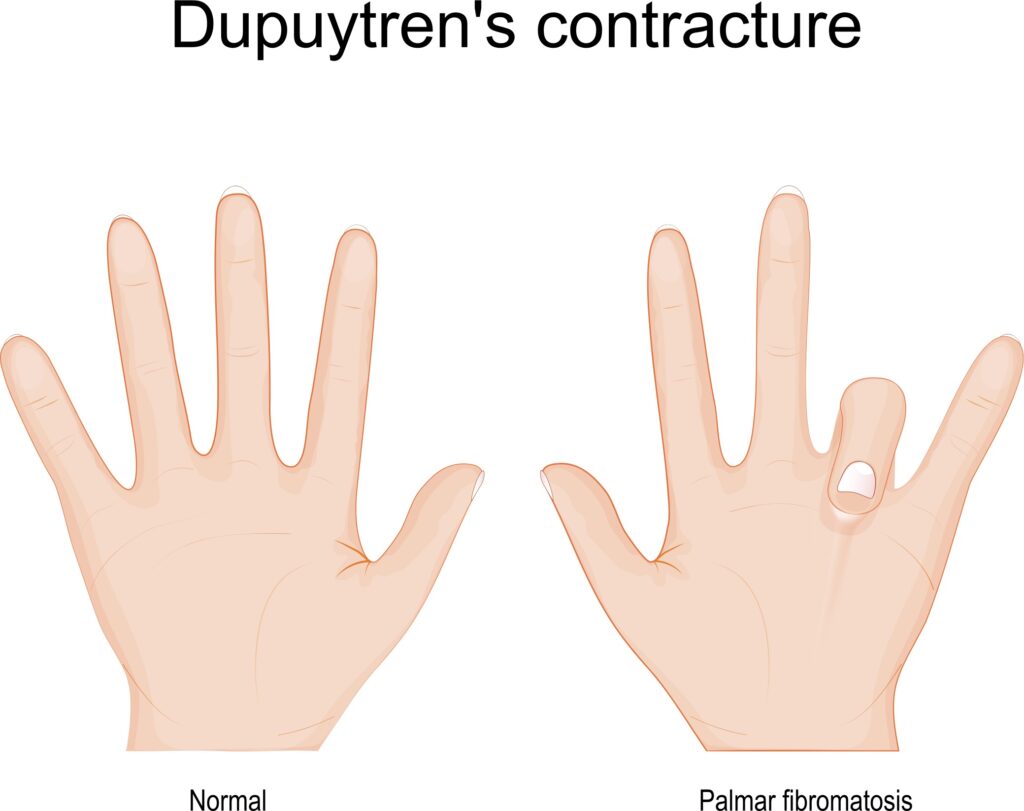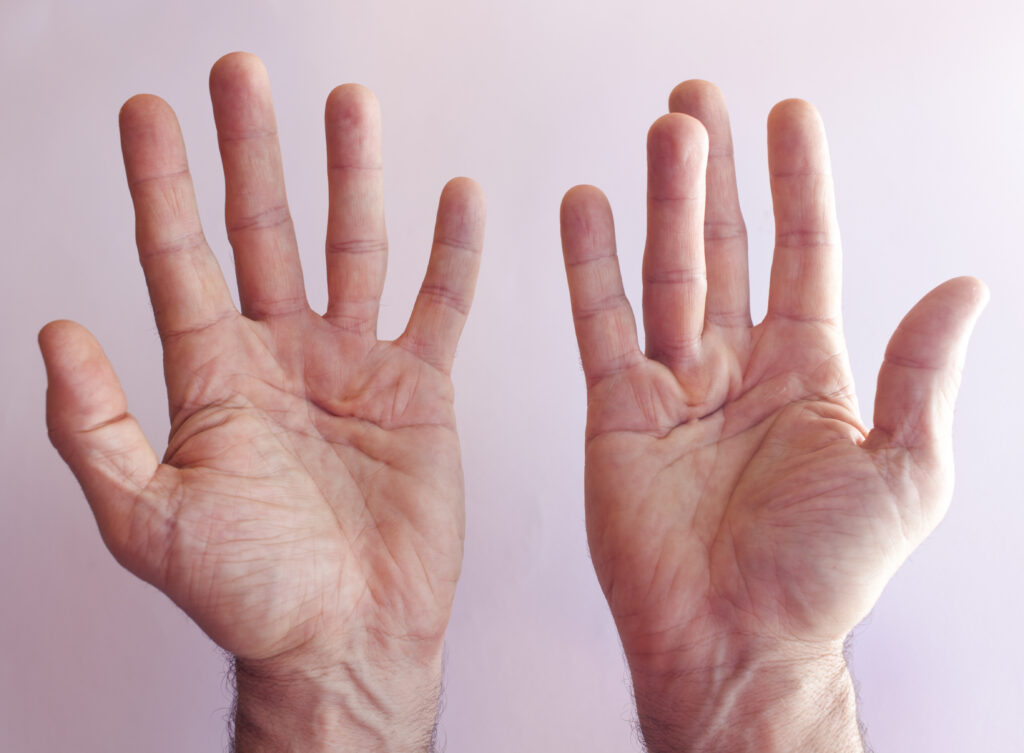The abnormal thickening of the tissue under the skin in the palm can cause a thick band or lump that can, over time, cause the fingers to curl and pull inwards or sideways towards the palm. The condition is known as Dupuytren’s contracture.
Dupuytren's Contracture Surgery Overview
- Surgery Time: 60-90 minutes
- Anaesthetic: Local or general
- Hospital Stay: Same-day
- Dressing and Garments: Stitches for 3 weeks
- Time Off Work: Up to 6 weeks
- Exercise: After bandage is removed
- Mobile: Same day
- Washing: Following day
- Sleeping Position: Keep hand elevated, propped on a pillow for 2-3 days
- Full Recovery: 4-12 weeks
What is Dupuytren's Contracture?
Also referred to as Dupuytren’s disease, the disease causes an abnormal thickening of the fascia resulting in the curling of one or several fingers. The disease affects the ring and little fingers mostly and, in some cases, can occur on both hands. While it’s rare, the condition can also affect the toes.
Dupuytren’s contracture has no cure. The only thing that the doctor can do is straighten the fingers if they’ve already curled. The disease progresses slowly, and there is nothing the doctor can do in the early stages.

What's the Cause of Dupuytren's Contracture?
The exact Dupuytren’s contracture cause is not known. Genetics and family history, however, are contributing factors. At the same time, the condition is more common in men and those over 40.
Some conditions are associated with Dupuytren’s contracture, like diabetes, smoking, alcohol, ageing, and a lower body mass index. There is usually no evidence that hand injury can increase the risk of Dupuytren’s contracture. However, for someone already at risk, trauma to the hand can accelerate the progression of the disease. Sometimes, patients develop a single nodule in the palm following a wrist fracture. The nodule, while tender, doesn’t often result in bending of the finger joint.
Trigger Finger vs Dupuytren's Contracture
The two conditions are often confusing because they have almost the same symptoms. For one, in trigger finger, the finger is bent, but you can always straighten it. This is not the case with Dupuytren’s contracture since surgery is the only way the finger can straighten.
Regarding treatment, mild cases of trigger finger can be treated conservatively. Treatment options include cortisone injection and administration of oral anti-inflammatory medication. However, if these fail, surgery may be recommended. Trigger finger surgery involves opening the tendon sheath, which enlarges the space and helps release the swollen tendon so the finger can straighten. The surgery is done under local anaesthesia, and the incision covered with sutures the doctor will remove after 2 weeks. You can resume light activities in 1 to 2 weeks and heavy lifting and manual labour in 4 to 6 weeks.
There’s no treating Dupuytren’s contracture symptoms with conservative measures, as surgery is the only option. Surgery is done on an outpatient basis under general anaesthesia. The doctor then closes the area with sutures that you will remove after 3 weeks. After surgery, you will need to wear a splint for Dupuytren’s contracture for at least 1 week. Occupational therapy can help when it comes to scar massage and improving the range of motion. You can return to normal activities 6 weeks after the procedure.

What are the Symptoms of Dupuytren's Contracture?
Dupuytren’s contracture progresses slowly over the years. Early stage Dupuytren’s contracture involves the thickening of the skin on the palm. As the disease progresses, the skin on the palm might appear dimpled or puckered before a lump of tissue forms. The lump is sensitive to the touch but not painful at this stage. After the initial growth, the lumps keep their size for 5 to 6 years before the contraction begins.
In the later stages, cords of tissue form under your skin and can even extend to the fingers. The fingers get pulled towards the palm as the cords continue to tighten. At this stage, the affected person starts considering Dupuytren’s contracture treatment. Dupuytren’s contracture, as mentioned earlier, can occur in one or both hands. If it occurs in both hands, one of the hands is usually more severely affected than the other. Dupuytren’s contracture causes symptoms like:
- Decreased motion range in the hand
- Finger joint stiffness
- Difficulty straightening the right or little finger
- Constantly get your hand stuck when you put it in a pocket
Dupuytren's Contracture Treatment
Dupuytren’s contracture surgery is usually the best treatment for the disease, at least in advanced stages.
In advanced cases, the affected fingers may not straighten entirely after treatment and may also lose their strength and flexibility. In some cases, the condition comes back after a few years. Ideally, Dupuytren’s contracture treatment involves the following plans:
Dupuytren’s Contracture Surgery
Surgery helps to straighten the affected fingers. Your doctor will make an incision along the finger or palm. Usually, surgery is done under either local or general anaesthesia. The doctor will straighten the finger, and you will be able to go home the same day.
Dupuytren’s contracture surgery recovery time varies from one person to another. Ideally, you should expect it to take about 4 to 12 weeks, depending on the extent of the procedure. Unlike other treatment options, surgery guarantees that the contracture won’t return. Like all surgical procedures, the surgery comes with certain risks like numbness, bleeding and infection at the incision site. Follow all your doctor’s post-surgical instructions to minimise the risk of complications and facilitate faster healing.
Needle Fasciotomy
The procedure involves using a needle to straighten the fingers. The doctor will insert a needle along your fingers and palm to straighten the affected fingers. The procedure requires local anaesthetic, and you go home the same day. The procedure isn’t as long-lasting as the Dupuytren’s contracture can come back years later. Recovery takes about 2 weeks.
Dermafasciectomy
This involves combining surgery and skin grafting to straighten the fingers. It is similar to fasciectomy, but the doctor removes all the affected skin and replaces it with a graft from other body areas. General or local anaesthesia is used. Most patients have to go through two procedures. The first procedure helps straighten the finger, while the second one helps add the skin graft. This usually occurs 4 days after the initial procedure. Recovery time is much longer, but you go home with the assurance that the condition won’t recur. The surgery carries the risk of numbness, bleeding and infection at the incision site.
Dupuytren's Contracture Treatment UK at The Harley Clinc
Are you experiencing symptoms that you think might be from Dupuytren’s contracture? Book a consultation today with an expert at the Harley Clinic, London.
Further Reading:
- What’s the Difference Between Trigger Finger vs Dupuytren’s Contracture?
- What Happens During Early Stage Dupuytren’s Contracture?
- How Long Do Ganglion Cysts Last?
- What is the Difference Between De Quervain Syndrome vs Carpal Tunnel?
- What is De Quervain’s Syndrome?
- How Long Does Dupuytren’s Contracture Take to Develop?
- How to Sleep with Carpal Tunnel Syndrome
- 5 Common Types of Hand Surgery
- Hand Surgery Recovery: What is Hand Therapy?
- Dupuytren’s Contracture Exercises After Surgery: What to Expect
- What Causes Dupuytren’s Contracture?
- What Happens During Dupuytren’s Contracture Surgery?
- Splints for Dupuytren’s Contracture 101










